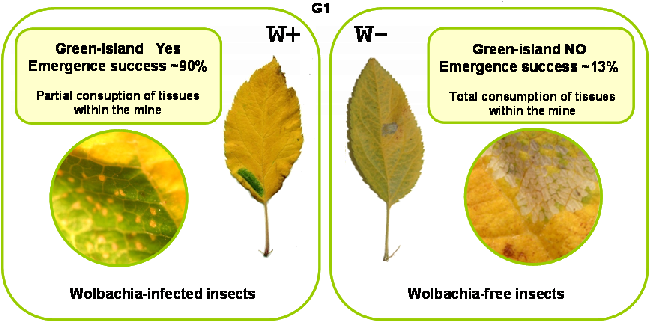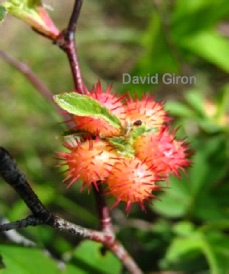


Key references in this research topic:

What is the question and the organisms studied?

What did we found so far?

What next?


People involved in this research topic:
Key references in this research topic:

Institut de Recherche sur la Biologie de l'Insecte
UMR 7261 Faculté des Sciences et Techniques
Avenue Monge, Parc Grandmont
37200 TOURS (France)

The sedentary behaviour of endophagous arthropods (i.e.; living within plant tissues)
makes them ideal systems for interpreting the ecological and evolutionary mechanisms
of herbivory and related questions such as plant resistance or physiological manipulation.
Such intimate associations are expected to facilitate close interactions between
independent genomes leading to biochemical and hormonal cross-
Figure 1. Host-
We also seek to identify insect effectors produced and involved in the plant manipulation
and to estimate the impact of the internal-

Figure 2. influence of Wolbachia on "green-


Our recent findings reveal an unexpected capacity of leafminers to manipulate the
plant physiology to their own advantages. Our results on the Malus domestica/Phyllonorycter
blancardella plant-
(i) The ability of this leafminer caterpillar to manipulate its host plant in order to generate a microenvironment with all the nutrient supply (sugars and proteins) needed for its survival.
(ii) A decrease in plant defences compounds within the mined area. We recently identified major molecular steps on which the insect can act and the metabolic consequences for the phenylpropanoids pathway.
(iii) A large accumulation of cytokinins in the mined tissues which is responsible
for the preservation of functional nutrient-
(iv) The primary role played by endosymbiotic bacteria (Wolbachia) in the synthesis
of these cytokinins and in the induction of nutrient-
We are currently investigating more specifically the sugar profile of mined areas compared to unparasitized tissues. Indeed, sugars not only play an important role as energetic substrates for the insect but also as signal molecules within the plant. Amino acids profiles are also investigated. We also investigate the plant molecular reconfiguration at a larger scale and the plant signaling pathways involved. We are furthermore currently developing a new research project on insect effectors produced by various “reprogramers” of plants.
In addition, several sub-
-
-
-
Giron D, Frago E, Glevarec G, Pieterse CMJ & Dicke M. (2013). Cytokinins as key regulators
in plant–microbe–insect interactions: connecting plant growth and defence . Functional
Ecology 27(3), 599-
Body M, Kaiser W, Dubreuil G, Casas J & Giron D. (2013). Leaf-
Robert C, Veyrat N, Glauser G, Marti G, Doyen GR, Villard N, Gaillard MDP, Köllner
TG, Giron D, Body M, Babst BA, Ferrieri RA, Turlings TCJ & Erb M.(2012) A specialist
root herbivore exploits defensive metabolites to locate nutritious tissues.Ecology
Letters 15 (1), 55-
Giron D. & Huguet E. (2011). A genomically tractable and ecologically relevant model
herbivore for a model plant: new insights on mechanisms of insect-
Kaiser W., Huguet E., Casas J., Commin C. & Giron D. (2010) Plant green-
Jérôme Casas
Jean-
